This question is closely related to ‘how often should I change my strings?’ and that old chestnut will be addressed a little later. First, we’re going to look at the different types of strings to make sure you pick the correct set for your instrument and playing style.
Different Types
Before we get into the smaller nuances, it’s important to make sure you’re looking for the
correct type of string for your instrument. There are three main types of basic guitar strings; Steel acoustic strings, Nylon acoustic strings and Electric guitar strings. 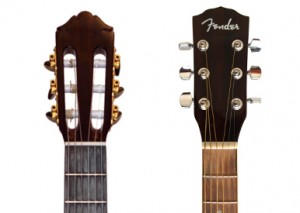
The most common type of strings, steel acoustic strings will suit an acoustic guitar
designed to accommodate these strings. These instruments are generally identified by string posts on the headstock where the steel strings are wound vertically.
Nylon acoustic strings are designed to suit a ‘classical’ type guitar characterised by a wider fingerboard and slots in the headstock around which the strings are wound horizontally. Typically, these guitars will not sport bridge-pins but facilitate through-bridge stringing.
Electric guitar strings are commonly made of different materials to steel acoustic guitar strings. The phosphor and bronze in acoustic guitar strings will often make them golden or copper in color while the nickel in electric guitar strings gives them a silvery hue. Electric strings tend to be lighter on the bottom gauges and even though some manufacturers don’t distinguish between the two; there are many subtle differences.
String Gauge
Once you have chosen the correct type of string for your guitar, the next most important task is to chose the correct gauge. Gauge simply means thickness and putting the correct gauge strings on your guitar will greatly affect how it feels and how comfortable it is to play.
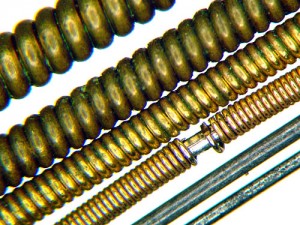 Heavier gauge strings boast more sustain, richer tone, more volume and a larger bass response but also can be less pliable due to greater tension, can sit higher off the fret board and can be harder on the fingers.
Heavier gauge strings boast more sustain, richer tone, more volume and a larger bass response but also can be less pliable due to greater tension, can sit higher off the fret board and can be harder on the fingers.
Lighter gauge strings are easier to bend as they require less tension to tune them to pitch. They also sit closer to the frets resulting in the player having to apply less downward pressure to achieve a clean sound.
More established players often chose their own string gauge to address tone and feel themselves but lighter gauges are certainly recommended for beginners. However, in some cases very light strings may sit too far down in the nut and drop the strings too close to the fingerboard resulting in ‘fret-buzz.’ Guitars can be adjusted for this but moving back up in gauge is advised.
Buying the right gauge
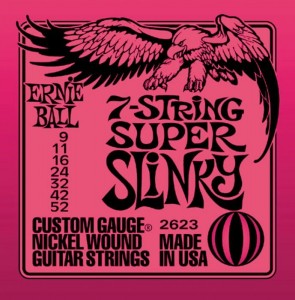 String sets will always have the gauge written on the outside of the packet. Most people use the imperial measurement system and reference the strings from the thinnest one. For instance this pack starts from 0.9 of an inch and works its way up to 0.52 of an inch (thinnest to thickest). In short terms, this packet of strings are called ‘nines’ after the thinnest string.
String sets will always have the gauge written on the outside of the packet. Most people use the imperial measurement system and reference the strings from the thinnest one. For instance this pack starts from 0.9 of an inch and works its way up to 0.52 of an inch (thinnest to thickest). In short terms, this packet of strings are called ‘nines’ after the thinnest string.
Standard electric guitarists would generally use 0.9 or 0.10 strings. 0.8 would be considered very light and 0.11 or 0.12 would be considered relatively heavy.
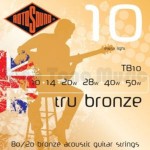 Acoustic steel strings generally work as follows:
Acoustic steel strings generally work as follows:
- 0.10 – Very light
- 0.11 – Light
- 0.12 – Light/Medium
- 0.13 – Medium/Heavy
- 0.14 – Heavy
Coated Strings
Coated strings are designed to extend the life of the string – that is to keep it sounding 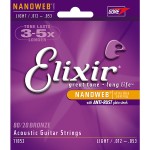 fresher and more vibrant for longer. This is done via a thin plastic coating on the strings to prevent dust and grit embedding between the notches of the wound strings. This residue prevents the string from vibrating and makes it sound dead ore lifeless. Coated strings are extremely efficient and work very well but can cost up to three times as much as regular strings.
fresher and more vibrant for longer. This is done via a thin plastic coating on the strings to prevent dust and grit embedding between the notches of the wound strings. This residue prevents the string from vibrating and makes it sound dead ore lifeless. Coated strings are extremely efficient and work very well but can cost up to three times as much as regular strings.
Flatwound Strings

Flatwound and groundwound strings are far less common than regular roundwound strings, these have specific uses and are used by differing styles of players for differing styles of music. For instance jazz players often use flatwound strings to achieve a more mellow sound and to reduce ‘string-squeak.’ Roundwound strings produce a brighter sound with longer sustain and this makes them the choice for most guitarists.
Brands
There are countless brands of guitar strings on the market, each boasting various material or build superiority over its competitors. The truth is that most un-coated strings are very similar and it would be hard to tell them apart once they’re out of the packet. Experienced guitar players will generally experiment with reputable brands like D’Addario, Rotosound, Ernie Ball or Martin and will pick the ones they feel most comfortable with. Many will find the extra life-span offered by coated strings like Elixir worth the extra cost.
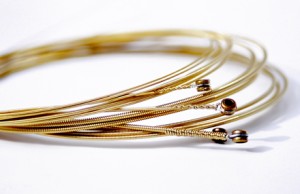 How frequently you should change your strings is simply down to how often you play your guitar. A good reference point is to change them if: (i) they sound dull or lifeless, (ii) they are quite dirty or (iii) you find the guitar hard to tune or it looses tune quicker that usual.
How frequently you should change your strings is simply down to how often you play your guitar. A good reference point is to change them if: (i) they sound dull or lifeless, (ii) they are quite dirty or (iii) you find the guitar hard to tune or it looses tune quicker that usual.
Happy playing
DM

